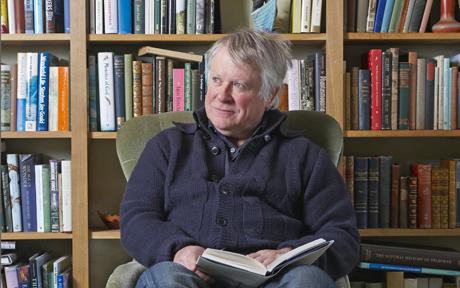|
|
|
|
Roydon
|
| Roydon lies on the
River Waveney two miles west of
Diss. The village is now home to one of the
country's most eminent nature writers: Richard Mabey.

Richard Mabey (Photo
© Mike Harrington)
After suffering a breakdown in 1999, Mabey moved
from his long-time home in the Chiltern hills to the
county and his gradual
recovery from depression is the subject of his moving
memoir
Nature Cure (2005). He was already
familiar with the county from trips to the North Norfolk
Coast when he was a student.
Blakeney
in particular helped to inspire his foraging classic
Food For
Free which was first published in 1972.
His Norfolk-based journey back to health was aided in
large part by Polly Munro - the daughter of a Neatishead
GP -
who he subsequently met; the couple now live
together in a farm house in the village. There is a touching
acknowledgement in the book's introduction to the part
she played in his recovery:
|
| 'Finally, more
thanks than I can express to Polly, who rescued me, took
a chance, and with love and patience buoyed me up, and
whose wisdom and sense of fun helped ease the moody
storms that go with writing a book. This is her book as
much as it is mine.' |
Nature Cure also features many other Norfolk locations including:
Blo' Norton and Hinderclay
fen, Horsey marshes (where Mabey saw cranes), Sculthorpe
on the River Wensum,
South Lopham Fen, Wayland Wood (near Watton)
and Strumpshaw Fen - which was one of the
first places he went after his recovery:
|
| 'Polly,
thank goodness, had the nous to take me straight out
into a wild spot, and meet that 'hard, emphatic'
presence on more even terms. We went to the fen at Strumpshaw on the western edge of the Broads. It was a
mild, hazy afternoon. I was shaky on my feet, but said
the mantra to myself. Listen. Look up. It wasn't easy,
this time for the best of reasons. The fen flowers were
beginning to unfurl at my feet.....' |
Mabey, a self-taught biologist, first discovered a love
of nature in the beech woods of the Chilterns where he
grew up. He went on to study politics and philosophy at
Oxford and then worked as a social studies lecturer
before becoming an editor at Penquin Books. He has
written over 40 books about nature including: a
biography of Gilbert White, Flora Britannica,
The Unofficial Countryside and more recently Weeds.
He is also a regular contributor to magazines, TV
and radio.Norfolk has had a long tradition of important nature
writers - starting in the seventeenth century with the physician
Sir Thomas Browne - and including the likes of
Arthur Patterson aka 'John Knowlittle' (see
Breydon Water), Ted Ellis
(see Surlingham) and Mabey's friend and co-author Mark
Cocker - who now lives at Claxton in the
Yare Valley.
Inside
the church in Roydon are memorials to the Frere family
who were once lords of the manor here. One of their number,
John Hookham Frere, is remembered for his accomplished
translations of Aristophanes.
|
|
|
|

